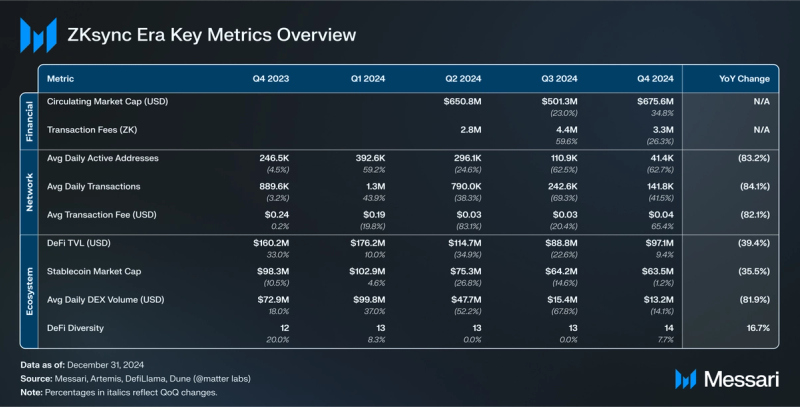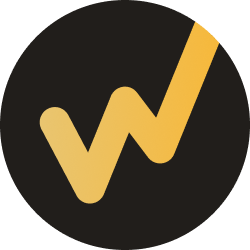Key Insights
- ZKsync’s Elastic Network vision, introduced in Q3 2024, aims to create a unified network of ZK-powered blockchains offering enhanced scalability, low-cost transactions, and seamless interoperability across multiple blockchain ecosystems.
- Institutional adoption of ZKsync technology has increased, with Deutsche Bank’s Project Dama 2, Blockchain Capital’s, and Tradable’s migration to the platform indicating a growing acceptance of ZK solutions.
- ZKsync Era is now the second blockchain for RWA assets. The chain has 28 RWAs and $1.9 billion (~25% of market share) in total value as of February 11, 2025.
- The ZKsync ecosystem has grown, with DeFi TVL reaching $97 million and expanding into diverse sectors, including gaming and AI applications.
- Community engagement has been a focus, with initiatives like the “Syncmas” NFT campaign. Syncmas was a giveaway initiative by ZKsync during the holiday season.
Primer
ZKsync’s ecosystem is powered by the ZK Stack, a modular framework enabling developers to build interoperable and customizable blockchain networks known as ZK chains. These hyperchains, part of the Elastic Network ecosystem, operate within a shared system of hyperbridges to facilitate liquidity and composability across the network.
ZKsync Era (ZK) is an Ethereum L2 designed to enhance blockchain capacity while maintaining security and decentralization. As an EVM-compatible validity rollup, ZKsync processes transactions off-chain and posts cryptographic proofs back to Ethereum for verification, enabling efficient and cost-effective operations. The platform employs advanced cryptographic methods, including zk-SNARKs and zk-STARKs to balance scalability with flexibility.
Matter Labs saw the potential of building a zk-solution for rollups and launched ZKsync Lite (originally called ZKsync 1.0), a simple peer-to-peer payment protocol, in December 2020. Two years later, Matter Labs coined the term “zkEVM” in an announcement of plans to build a zk-powered smart contract platform. And in March 2023, it launched ZKsync Era (originally called ZKsync 2.0), the first mainnet zkEVM. ZKsync is now poised to accelerate the mass adoption of crypto by scaling Ethereum with interconnected zk-powered ZK Chains.
To help realize this vision, Matter Labs raised $258 million from various investors, including a16z, Union Square Ventures, Blockchain Capital, Dragonfly Capital, and others. ZKsync offers features such as native account abstraction, flexible gas payment options, and efficient cross-chain interoperability. For a full primer on Zksync Era, refer to our Initiation of Coverage report.
Website / X (Twitter) / Discord
Key Metrics
Financial Analysis


After a late Q2 token release, ZK’s market cap grew by 35% QoQ in Q4 to $676 million. The token price also grew by 35% to $0.18 from $0.14 as there were no token unlocks in Q3 or Q4. By the end of Q4, its market cap amongst all tokens fell from 121 to 126.
ZK’s first unlock will happen in June 2025, with 124 million ZK ($25 million) being unlocked to the team and 132 million ZK ($27 million) being unlocked to investors. Linear monthly vesting will continue to these two groups over four years until the team has 16.1% of supply and investors have 17.2% of the supply. Another 10.33 billion tokens are available to be distributed from the ZKsync Foundation and ZKsync Token Assembly. The ZKsync Foundation’s allocation was immediately liquid and available for distribution, while the ZKsync Token Assembly allocation will become liquid once onchain governance is enabled.

In Q4, the ZKsync Era protocol received $567,000 in transaction fees, a 4% decrease QoQ. When denominated in ZK, the protocol received 3.3 million ZK, a 26% decrease QoQ from 4.4 million ZK. With the introduction of EIP-4844 at the end of Q1, which decreased transaction costs on L2s by 100x, total fees paid on the protocol also dropped tremendously. From Q3’23 to Q1’24, there was a total of $58.3 million in transaction fees, and then in Q2’24, total transaction fees dropped by 88% QoQ to $2.5 million.
Network Analysis


In Q4, average daily transactions decreased by 42% QoQ from 242,600 to 141,800. Average daily active addresses decreased by 63% QoQ from 110,900 to 41,400. These dropoffs are mainly attributed to the lack of incentives to continue using the network post-airdrop. However, average daily new addresses only decreased by 2% QoQ from 12,400 to 12,100, signaling the protocol is still driving new addresses to interact with the network.

EIP-4844’s impact on users can be directly seen when the average transaction fee fell by 86% QoQ from Q1’24 to Q2’24, from $0.19 to $0.03. In Q4’24, the average transaction fee increased by 65% QoQ to $0.04. The decreasing trend in transaction fees paid by addresses proves the effectiveness of EIP-4844 and the current L2 scaling roadmap for the Ethereum ecosystem. When denominated in ZK, average transaction fees increased by 26% QoQ from 0.20 to 0.25.
The average daily transaction success rate was maintained at around 97%. Q4 also saw 66,600 new contracts created, a 67% decrease QoQ.
Technical Progress
The fourth quarter of 2024 saw advancements in the performance capabilities of ZK-based solutions, and the roadmap for 2025 was introduced. Key initiatives included:
- BoojumVM Development: ZKsync announced the upcoming BoojumVM, aiming to achieve an impressive 10,000 transactions per second at a cost of approximately $0.0001 per ERC20 transfer. This development, made possible by Boojum 2.0 and the state-diff architecture, aims to enhance the scalability and cost-effectiveness of ZK chains.
- AI Integration: The collaboration between ZKsync and SpaceandTimeDB to bring AI Agents for trading to the testnet showcased the potential for integrating artificial intelligence with ZK-proven data. This innovation could lead to more secure and efficient trading systems, as well as novel DeFi applications that leverage the strengths of both ZK and AI technologies.
- Gasless Transactions: Several projects within the ZKsync ecosystem, including Sophon and Venus Protocol, implemented gasless transactions, improving the user experience and reducing barriers to entry for new users in the blockchain space.
- GRVT: In late December, GRVT launched its Mainnet Alpha. The team behind GRVT built a hybrid infrastructure DEX that blends CeFi and DeFi. Users can trade perps with zero gas fees and up to 50x leverage. Powered by ZKsync’s Validium technology, users’ on-chain trading data remains private while also allowing the DEX to remain compliant with KYC and AML laws.
- Zksync Single Sign On (SSO): In early December, the ZKsync team introduced ZKsync SSO, a toolkit designed to bring Web2-like user experiences to Web3 applications. This technology allows for passkey creation and authentication, removing the need for traditional transaction signatures and simplifying the crypto transaction process for users. The team created a demo showing the difference between common onchain experiences vs the new SSO experience.
The technological innovations in the ZK space during the fourth quarter of 2024 have set the stage for blockchain scalability, privacy, and performance advancements. ZKsync’s progress in ZK technology and improvements in privacy features and transaction processing capabilities position the platform at the forefront of blockchain innovation. These developments enhance the current capabilities of blockchain networks and open up new possibilities for decentralized applications across various sectors, from finance to gaming and social media.
As 2025 approaches, some anticipate it as “the year of ZK”. These technological innovations lay a foundation for continued growth and adoption of ZK-based solutions. The focus on improving user experience, enhancing privacy, and increasing transaction throughput while maintaining security and decentralization principles positions ZKsync and the broader ZK ecosystem to potentially reshape the blockchain landscape in the coming years.
Ecosystem Analysis

DeFi

In Q4’24, DeFi TVL increased by 9% QoQ from $88.8 million to $97.1 million. When denominated in ZK, DeFi TVL decreased by 19% from 650.7 million to 528.4 million. This puts it as the 28th chain in terms of TVL.
SyncSwap led all protocols on ZKsync Era with $23.7 million in TVL, a 2% increase QoQ to capture 24% of the market. Venus was second with $12.1 million in TVL, a 20% increase QoQ and a 12% market share. Aave was third with $10.9 million in TVL, a 261% increase QoQ and a 11% market share. At the end of Q4, ZKsync Era’s DeFi Diversity, the number of protocols that make up the top 90% of a network’s DeFi TVL, grew by 1 to 14.

In Q4’24, average daily DEX volume decreased by 14% QoQ from $15.4 million to $13.2 million. Maverick regained the top spot with an average daily volume of $2.8 million, a 1% increase QOQ, and a 21% market share. PancakeSwap fell to second with an average daily volume of $2.7 million, an 18% decrease QoQ, and a 20% market share. zkSwap Finance claimed the third spot with an average daily volume of $2.5 million, a 11% increase QoQ, and a 19% market share.

In Q4’24, ZKsync Era’s stablecoin market cap decreased by 1% QoQ from $64.2 million to $63.5 million. USDC is the largest stablecoin on the network, with $54.1 million which is a 87% market share. USDT launched on the network on September 12, and ended Q4 with $7.0 million which is an 11% market share. DAI and FRAX round out the next two largest stablecoins on the network with a combined $725,400, which is only a 1.2% market share. As the network continues to mature, the stablecoin market looks to saturate as well.
Ecosystem Growth
Elastic Network

In Q3 2024, ZKsync introduced its Elastic Network Ecosystem, evolving from a single Ethereum Layer-2 solution to a network of interconnected ZK chains. This architecture, announced on July 2, 2024, aims to address challenges of scalability and interoperability in the blockchain industry.
The Elastic Network Ecosystem comprises several key components working together to create an interconnected network of autonomous rollups. The ZK Router manages network state and facilitates interoperability, while the ZK Gateway enables ZK Chains to settle to Ethereum, offering proof composition and enhanced liveness. This architecture leverages recursive ZK proofs for scalability, enabling high transaction volumes without increasing verification time or cost.
The introduction of the Elastic Network Ecosystem has led to new partnerships and integrations. By the end of Q3, more than 20 new ZK Chains were expected to be live, indicating interest in this technology. Notable projects like ZTX announced their move to ZKsync, aiming to connect a community of over 500 million users. This migration demonstrates the Elastic Chain’s capacity to support large-scale applications and user bases.
The technical advancements underpinning the Elastic Network Ecosystem were substantial. Throughout Q3, the ZKsync Core underwent a series of updates, with 15 versions released between July and August 2024. These updates focused on enhancing performance, security, and functionality. Key enhancements included the integration of zksync_tee_prover, improved gas calculations for blob transactions, and the introduction of gossip-based node synchronization.
The Elastic Network Ecosystem aims to improve scalability and network efficiency. It allows for the creation of purpose-specific ZK Chains, enabling tailored solutions for different use cases while maintaining interoperability. This approach seeks to enhance transaction throughput and provide developers with greater flexibility in designing and deploying decentralized applications.
A significant development within the Elastic Network Ecosystem was the launch of Cronos zkEVM’s alpha mainnet on August 14, 2024. As a Layer-2 ZK chain alongside ZKsync Era, Cronos zkEVM implements the Elastic Chain concept. It introduces features such as zkCRO as its primary gas token and native account abstraction for flexible transaction-fee payments, showcasing the versatility of the ZKsync technology stack.
The Elastic Network Ecosystem focuses on interoperability, addressing a major challenge in the blockchain space – the fragmentation of liquidity and user experience across different networks. By enabling protocol-level transfers between ZK chains without Layer-1 transactions, ZKsync aims to create a more unified and efficient blockchain ecosystem, potentially benefiting both developers and end-users.
As the Elastic Network Ecosystem continues to evolve, it contributes to the “chain-of-chains” vision. It aims to provide a unified blockchain experience that functions as a network of interconnected chains while appearing as a single chain to users, potentially influencing the development of Layer-2 solutions. This approach offers an alternative to other scaling solutions in the decentralized finance and blockchain applications landscape. The approach presents an alternative in the evolving landscape of blockchain technology and adoption.
Deutsche Bank’s Project Dama 2
One of the notable developments in institutional adoption is Deutsche Bank’s Project Dama 2, unveiled in Nov. 2024 as part of the Monetary Authority of Singapore’s Project Guardian. This initiative involves the development of a Layer-2 blockchain on Ethereum using ZKsync technology, aiming to bridge the gap between blockchain innovation and regulatory compliance in traditional finance.
Project Dama 2 is characterized as “public and permissioned”, leveraging ZKsync’s ZK proof technology to enhance privacy and scalability while maintaining transparency. Key features of this project include:
- A soulbound token-based digital identity system
- Efficient gas fee management
- Tokenized fund creation via the Domani Protocol dApp
- Curated transaction validators and potential “super admin rights” for regulators
These features address concerns in the financial sector, particularly regarding inadvertent transactions with sanctioned entities and regulatory oversight. Deutsche Bank aims to launch a minimum viable product by 2025, subject to regulatory approval, potentially affecting wider adoption of blockchain technologies in the financial sector.
Other institutional adoption:
- On January 16, Tradable, a platform for asset managers to bring tokenized alternative assets to a Web3 audience, launched on ZKsync. The platform brought over $1.7 billion of assets across nearly 30 institutional-grade private credit positions.
- On February 13, Galaxy released a report highlighting ZKsync Era as the number two chain in terms of RWA count and total value. As of February 11, the chain held 28 RWAs with a value of $1.9 billion.
Governance Developments
Q4 2024 saw developments in ZKsync’s governance system, emphasizing the project’s commitment to decentralization and community-driven decision-making. A key development was the introduction of the ZKsync Ignite proposal, the first governance proposal presented to the Token Assembly. This initiative aimed to establish a liquidity hub for ZKsync by allocating 325 million ZK tokens (approximately $48.5 million) to enhance DeFi liquidity over a nine-month period.
The governance process also saw the implementation of proposals ZIP-001 and ZIP-003, which focused on enhancing the protocol’s code quality and gas efficiency. These proposals demonstrated the community’s involvement in technical improvements and the project’s commitment to transparency in decision-making.
Another governance development was the approval of ZIP-002, which aimed to reduce the execution delay on ZK Chains from 21 hours to three hours. This change, passed with a 99.8% majority, showcased the community’s support for improvements in operational efficiency and user experience.
Developer-Focused Programs
Recognizing the role of developers in ecosystem growth, ZKsync implemented several initiatives to attract and support blockchain developers:
- The Aligned Builders Hackathon, featuring a $50,000 prize pool, encouraged developers to explore and build ZK apps on Ethereum.
- Educational resources like @levelupweb3 were supported to cover topics such as Solidity and ZK technology, facilitating developer onboarding.
These developer-centric initiatives expanded the pool of developers working on ZKsync and fostered innovation within the ecosystem.
The combination of marketing campaigns, governance developments, token distributions, and developer support programs has contributed to the growth of the ZKsync ecosystem in Q4 2024. These initiatives have fostered community engagement and attracted a range of participants, from casual users to developers, in the Layer-2 solutions landscape.
Gaming and Social Media Integration
The integration of gaming and social media platforms into the ZKsync ecosystem marked an expansion beyond traditional DeFi applications:
- Gaming Ecosystem Migration: Treasure DAO, a leading Web3 gaming ecosystem, launched its mainnet on ZKsync on Dec. 11, 2024. This migration, one of the largest ecosystem transitions in crypto history, involved transferring over $200 million in assets, including 15+ games, MAGIC tokens, and hundreds of thousands of NFTs. The move showcased ZKsync’s capability to support complex gaming ecosystems with features such as gasless transactions and near-instant finality.
- Social Media Developments: Avara (formerly Aave Companies) secured $31 million in funding for Lens V3, a Layer-2 blockchain solution designed specifically for SocialFi applications. The transition of Lens from its initial Polygon-based infrastructure to ZKsync demonstrated the platform’s appeal for social media applications seeking improved performance and user experience.
- NFT Integration: The ecosystem’s growth in NFTs was evident through various initiatives, including the Syncmas campaign’s NFT giveaways and the integration of popular NFT projects like Pudgy Penguins into community engagement efforts.
Closing Summary
The fourth quarter of 2024 has been a period of growth and innovation for the ZKsync ecosystem, characterized by technological advancements, expanding institutional adoption, and a flourishing community. The introduction of the Elastic Network vision has positioned ZKsync among blockchain scalability solutions, aiming for seamless interoperability and enhanced performance across multiple chains. This project, coupled with the development of technologies like BoojumVM and ZKsync SSO, demonstrates Zksync’s commitment to advancing blockchain capabilities. The ecosystem’s growth is further evidenced by the integration of diverse sectors, including DeFi, gaming, and social media, showcasing ZKsync’s versatility across various blockchain applications.
Institutional adoption has emerged as a key narrative this quarter, with projects like Deutsche Bank’s Dama 2, Blockchain Capital’s, and Tradable’s migration to ZKsync signaling growing interest in ZK technology among traditional financial players. This trend, combined with the increase in community engagement through campaigns and governance initiatives, has created a foundation for ZKsync’s continued expansion. As the regulatory landscape evolves to address the unique properties of ZK technology, the proactive compliance efforts within the ZKsync ecosystem position it to navigate future challenges and potentially influence the development of balanced regulations. ZKsync continues to develop scalable, secure, and user-friendly decentralized applications for various industries.

















